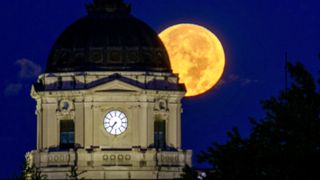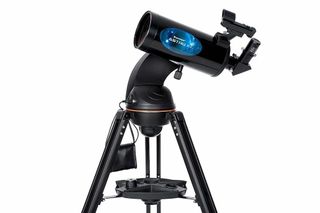The Strawberry Full Moon of 2024 rises near the June solstice with an Antares encounter
It will occult Antares when nearly full, too.
The full moon of June, also called the Strawberry Moon, will occur on June 21 at 9:08 p.m. Eastern Daylight Time (0108 UTC June 22), according to the U.S. Naval Observatory. Observers in Oceania will see a nearly full moon pass in front of the star Antares, Alpha Scorpii, the brightest star in Scorpius, the Scorpion, on June 20.
In New York City, moonrise will occur at 8:49 p.m. EDT on June 21. The sun will set at 8:31 p.m. EDT on that day. This full moon happens on the day after the Summer Solstice, the longest day of the year; full moons occur within a day of the solstices about every 19 to 20 years. There's some dispute about what counts as a full moon falling "on the solstice" – it depends on how close in time one wants the two phenomena to be. For example, the Summer Solstice in 2024 is counted as occurring at 4:05 p.m. EDT on June 20, and the full moon is a little more than 30 hours later.
The moon will pass in front of – or occult – Antares the day before the full moon, but the event won't be visible from New York. North American sky watchers will see a very close pass of the moon just to the south of, or "below," Antares.


Looking for a telescope to see the moon? We recommend the Celestron Astro Fi 102 as the top pick in our best beginner's telescope guide.
A full moon happens when the moon is opposite the sun with the Earth between the two. On the night side of Earth, that's when viewers can see a fully illuminated moon. Full moons are reckoned relative to the positions of the moon and Earth; the timing of a full moon is the same all over the world, meaning any perceived differences in such timing are solely due to one's time zone. While the moon turns full at 9:08 p.m. EDT in New York, for a London-based sky the full moon occurs at 1:08 a.m. local time the next day, and a Japan-based observer would see it happen at 9:08 a.m. local time.
Related: June full moon 2024: The Strawberry Moon follows the solstice
While many around the world will only see the moon closely passing Antares, those located in a swath of the Pacific Ocean will see the moon pass in front of the star, which is the brightest in the constellation Scorpius, the Scorpion. One of the larger cities this occultation will be visible from is Port Moresby, in Papua New Guinea, where one can see the moon touch Antares on June 21 at 8:10 p.m. local time, according to In-the-sky.org, and Antares will appear to emerge from behind the moon at 8:34 p.m.
Other places where one can see the occultation include Suva, in Fiji, where Antares passes behind the moon June 21 at 11:04 p.m. local time and emerges at 12:21 a.m. local time on June 22.
Get the Space.com Newsletter
Breaking space news, the latest updates on rocket launches, skywatching events and more!
Unlike lunar phases, spotting occultations is affected by one's location. In the case of occultations by the moon, our natural satellite is close enough that moving from one part of the Earth's surface to another can alter the moon's apparent position against the stars by up to two degrees. So, an observer in Honolulu, which is further north than Fiji or the Solomon Islands, will see the moon pass just to the south of Antares, in close conjunction at about 1:33 a.m. local time on June 21; the moon will pass about 0.3 degrees south of the star, less than a single lunar diameter (the moon is so bright that Antares can be hard to spot so close by).
Other regions will be on the day side of Earth, so the Moon wouldn't have risen yet or will have set already when the occultation occurs.
Visible Planets
Besides getting to see the moon occult Antares, Saturn, Mars and Jupiter will also be visible in predawn skies; Mercury, Venus and Jupiter will be largely lost in the sunlight for people in mid-northern latitudes.
Saturn will be the first to come up — the planet will rise at 12:34 a.m. EDT on June 22 in New York City. Mars follows at 1:31 a.m. EDT. Saturn will be in the constellation Aquarius, and, as it is relatively bright, it will stand out against Aquarius' fainter stars — in many city locations, Aquarius is barely visible, so Saturn looks like the only bright "star" in that part of the southeastern sky. Mars is recognizable by its red-orange color, and the planet is in the constellation Pisces, another group of mostly fainter stars. By about 3:30 a.m. EDT, Mars will appear to be about 10 degrees above the eastern horizon and to the left of Saturn which will be in the southeast about 30 degrees high.
Jupiter rises just before dawn, at 3:51 a.m. EDT; in New York sunrise is at 5:25 a.m. EDT on June 22. By about 5 a.m. EDT, Jupiter will be 10 degrees above the east-northeastern horizon, and the sky will start getting lighter. Jupiter, Mars and Saturn will form a line that makes about a 45 degree angle to the horizon, with Mars at 27 degrees and Saturn at 40 degrees in the southeast. A fun exercise is to see how close to sunrise one can still spot all three planets.
For both the planets and the sun, rising times will be similar in other mid-northern latitude locations such as Chicago, Sacramento and Denver.
For those watching the sky from south of the equator, Saturn and Mars will appear higher in the sky by the time the sun comes up. Because June 20 is the winter solstice there, it will be the longest night of the year. Another effect on planetary observing is the angle the ecliptic — the projection of the Earth's orbit on the sky and the apparent path of the sun against the background stars — makes with the horizon. Planets hug the ecliptic — none of them move more than a few degrees from it. Mercury's orbit has the highest inclination to the ecliptic plane, at about 7 degrees.
From a mid-southern latitude such as in Melbourne, Australia (where the full moon occurs at 11:08 a.m. local time on June 22) sunset is early, at 5:08 p.m. local time and the full moon rises at 4:58 p.m. local time. Saturn will rise at 11:17 p.m. local time, followed by Mars at 3:27 a.m. local time on June 23, and Jupiter — which is nearly lost in the sunlight in the Northern Hemisphere — rises at 5:38 a.m. local time. From Melbourne, by about 6:30 a.m. in the area, the three planets will form a rough line from Jupiter in the northeast to Saturn in the north. As the sun rises later — at 7:36 a.m. local time on June 23 — by the time the sky begins to get lighter, Saturn will have moved into the west and be more than halfway (about 55 degrees high) to the zenith.
Join our Space Forums to keep talking space on the latest missions, night sky and more! And if you have a news tip, correction or comment, let us know at: community@space.com.

Jesse Emspak is a freelance journalist who has contributed to several publications, including Space.com, Scientific American, New Scientist, Smithsonian.com and Undark. He focuses on physics and cool technologies but has been known to write about the odder stories of human health and science as it relates to culture. Jesse has a Master of Arts from the University of California, Berkeley School of Journalism, and a Bachelor of Arts from the University of Rochester. Jesse spent years covering finance and cut his teeth at local newspapers, working local politics and police beats. Jesse likes to stay active and holds a fourth degree black belt in Karate, which just means he now knows how much he has to learn and the importance of good teaching.